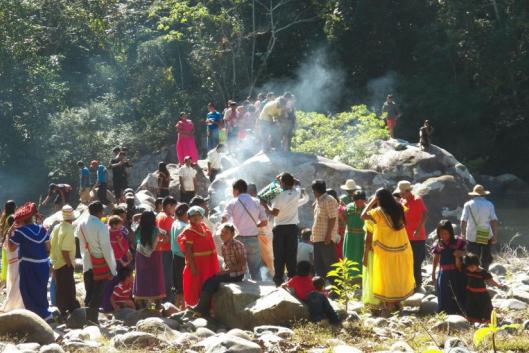With a history plagued by outrage and territorial imposition since colonization, the indigenous Ngäbe-Buglé peoples of western Panama struggle relentlessly for autonomy, and freedom from mining, hydroelectric and other destructive industries in their territories (1).
Nowadays, even the most destructive industries can obtain "green seals" to sell environmentally friendly images, or to finance "offset" projects—which theoretically restore lost biodiversity or counteract emissions. However, these strategies do nothing more than deepen the current extractive model, by making consumers believe that destruction is being "offset," or that a destructive project is somehow "sustainable."
In the face of this trend, which converts polluters into "green" companies and uses slogans on sustainability, communities affected by the operations of these companies are carrying out a strong resistance. This is how the Ngäbe-Buglé territory became a source of inspiration. In 2010, their struggle pushed the government into passing a law banning mining and hydroelectric projects in the region. In March 2017, El Salvador also passed legislation banning all metal mining in the country, after strong protests (2). Costa Rica also has a national ban on open-pit metal mining, resulting from over 15 years of popular resistance (3). And in March 2017, a municipality in southern Colombia secured a ban on what would have been the world's largest open-pit gold mine. The ban followed community resistance after the vast majority of the population that would have been affected opposed the opening of the mine (4).
In this occasion we speak with Rogelio Montezuma, head of the Committee for the Defense of the Rights of the Ngäbe-Buglé, a key player in the resistance against the copper mine at Cerro Colorado and hydroelectric dams.
Interview with Rogelio Montezuma
- What were the mining and hydroelectric plans in the region?
The government plans were to activate a mining concession in the Ngäbe Buglé territory in 2010, reforming the national mining code to promote foreign investment. This also would have allowed the issuance of a water concession for construction of a hydroelectric dam, which the population strongly rejected in 2011 and 2012. Consequently, the then government of Ricardo Martinelli repealed the law that would have changed the mining code; and he legislated another law banning mining exploration and exploitation, as well as hydroelectric projects, in the Ngäbe Buglé region.
- Why was and is it so important to protect Cerro Colorado against extractive industries?
It is important to protect Cerro Colorado for its biodiversity and rivers, on which Ngäbe communities depend for their indigenous culture, traditions and customs. The area is particularly important for the rivers, because it contains their headwaters and springs, and because these rivers supply water to both indigenous and non-indigenous populations. In addition, geographically speaking, Cerro Colorado is considered to be part of a Mesoamerican biological corridor and the lung of the region.
- How did you organize the resistance? What was the strategy?
The consciousness of this region's inhabitants is what has maintained the resistance. To this aim, information was shared with communities about the negative social, environmental and cultural impacts of mining; by projecting videos about the bad experiences other indigenous groups have had with the mining industry.
- How did you confront government-deployed criminalization and repression?
The Ngäbe peoples made a conscious decision to fight for their lives. They never gave up their resistance—despite the massacre and brutal repression perpetrated by national police—until they were able to establish the agreement with the Panamanian government guaranteeing Ngäbe territory would remain free from mining and hydroelectric projects.
- Why did the agreement against mining and hydroelectric projects in the region not affect the Barro Blanco dam?
The agreement established after the repression became the law prohibiting both mining exploration and exploitation and dams in the region. It was not possible to cancel the Barro Blanco dam, as it lies outside the area's boundaries; this is in spite of the fact that it impacts and affects Ngäbe communities that live on the banks of the river where the dam was built.
- Can you already see impacts on communities and forests as a result of the dam's implementation? If so, what are they?
The real impact is the flooding that is affecting communities living on the banks of the Tabasara river, when the reservoir filled up. But resistance continues and the families affected people have reached such a point of desperation that we do not know what will happen in the near future.
- How can people on the outside support the struggle of Ngäbe-Buglé peoples today?
People's conscious participation and awareness is key in the face of any potential scenario, in which there could be attempts to impose similar projects on people. Defending legislation is also necessary, now and always.
(1) http://wrm.org.uy/oldsite/countries/Panama/article1.html ; http://wrm.org.uy/oldsite/boletin/46/Panama.html
(2) https://ramumine.wordpress.com/2017/03/31/el-salvador-prizing-water-over-gold-bans-all-metal-mining/
(3) http://www.bdlaw.com/assets/htmldocuments/Costa%20Rica%20Proyecto-159481.pdf
(5) Ver: http://www.radiotemblor.org/prohiben-la-mineria-a-cielo-abierto-en-areas-protegidas-de-panama/
